

Knit to Fit: Vertical Darts II (for Bottom Up sweaters) – Deb Gemmell: Top Down, Gauge Free and more. Let’s say you have a pattern for a sweater with a straight body.

You’ve worked your sweater from the bottom up and to accommodate your figure, you have worked increases between your waist and your bust, making Vertical Darts to add extra width at the bust. Now things get interesting. You have to work decreases to get back to the correct number of stitches for the upper chest and the shoulders on your pattern. How and where can you do this?
Here are three ways. OPTION 1: You can continue the princess lines straight up to the shoulder. Keep the markers used in your Vertical Darts in place and work a decrease before the first marker and after the second marker as your work up to the shoulder. If I was doing this option I might consider making the princess lines prominent. How to work bust darts with the Cocoknits Method. Bust Darts for Blue - Fashion: Yarn Style. Here is the breakdown of the horizontal bust darts that I added to Wendy Bernard’s top down pattern for Blue: First of all, the whole idea behind horizontal bust darts is that you are taking a two-dimensional piece of fabric and turning it into a three-dimensional shape in one area.
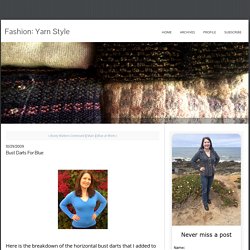
Instead of knitting down continuously in the round, you create a three-dimensional space in front, a pocket, if you will, for your breasts to fit into. Then, once you have created this pocket, you pick up your wraps and go back to your knitting in the round, resuming the two-dimensional fabric. In order to do this kind of pinpointed garment construction, you have to bring the seriousness of a dressmaker to calculating your measurements. It's really not that hard, especially if you get someone else to measure you. Knitting Bust Darts. Knitting Bust Darts with short rows and vertical darts allows custom contour shaping in hand knit garments.
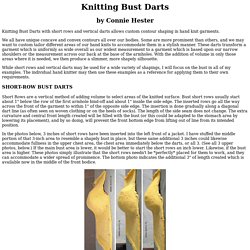
We all have unique concave and convex contours all over our bodies. Some are more prominent than others, and we may want to custom tailor different areas of our hand knits to accommodate them in a stylish manner. These darts transform a garment which is uniformly as wide overall as our widest measurement to a garment which is based upon our narrow shoulders or the measurement across our back at the base of the armholes.
With the addition of volume in only those areas where it is needed, we then produce a slimmer, more shapely silhouette. While short rows and vertical darts may be used for a wide variety of shapings, I will focus on the bust in all of my examples. Short Rows are a vertical method of adding volume to select areas of the knitted surface. How (& Why) to Work Bust Darts - Cocoknits. Like we said before, you can dive into the math of this with Amy Singer’s book, Big Girl Knits or through this great Ravelry group: The Bust Line.
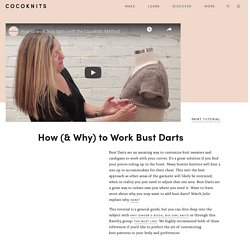
For this tutorial, we're not going to be that precise. For this project, Emma Version C we had a gauge of 4.5 rows per inch. If you're around a B or a C cup you're probably going to want around 4-6 extra rows (adding about .75-1.25 inches). Free Tutorial: Bust Dart Shaping for Top-Down Sweaters. There are a number of bust dart tutorials out there, and many of them are wonderful.
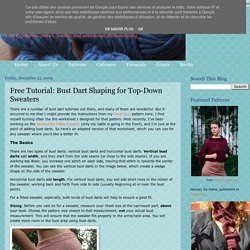
But it occurred to me that I might provide the instructions from my Celia Cruz pattern here. I find myself turning often the the worksheet I designed for that pattern. Most recently, I've been working on the Backward's Cable Pullover (only my cable is going in the front), and I'm just at the point of adding bust darts. So here's an adapted version of that worksheet, which you can use for any sweater where you'd like a better fit. How to Knit Better Short-Row Bust Darts – TessKnits.com. One fitting issue some women have is how to fit a sweater for a generous bust without it becoming a gunny sack.

You may not know that the “Ms. Average” that the the fashion industry designs for is a B cup. So if you are larger than a B cup, OR if the difference between your upper chest circumference and your bust circumference is more than an inch or so, AND you are making a fitted style sweater, you will probably want to include some bust shaping. I have basically no background in the generous bust department. But some of my students do. Stitched Together: Short Row Shaping (Knitting Sideways Bust Darts) One of the main attractions (for me) of making your own clothes is getting them to fit right.
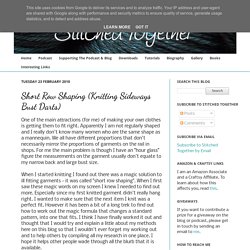
Apparently I am not regularly shaped and I really don't know many women who are the same shape as a mannequin. We all have different proportions that don't necessarily mirror the proportions of garments on the rail in shops. For me the main problem is though I have an "hour glass" figure the measurements on the garment usually don't equate to my narrow back and large bust size. (544) Add Bust Darts to your Knitting Pattern for the Perfect Fit with Amy Herzog.
How to Add Short Rows to Your Sweater. The instructions will work for both top-down and bottom-up sweaters, but the wedge will either be smaller on top or on the bottom depending on which direction you’re knitting.

This won’t impact how the short rows work. How many short rows should I do? You may have heard of the convention of knitting a certain number of short rows depending on your cup size. I don’t like that approach, and I find that it does not work for really large busts. I recommend a different approach. Take a tape measure and write down two measurements – full bust length (#3 below) and outer bust length (#4). The difference in these two measurements is a good approximation of the height of short rows you need to do. Note: I’m using inches but metric units will work exactly the same way. Let’s take a real world example. Gauge: 20 sts and 24 rows over 4 in / 10 cmOuter Bust is 13 inchesFull Bust is 16 inches.Front width is 19 inches Calculate the additional length needed.
How to Add Short Rows to Your Sweater - knotions. The instructions will work for both top-down and bottom-up sweaters, but the wedge will either be smaller on top or on the bottom depending on which direction you’re knitting.

This won’t impact how the short rows work. How many short rows should I do? FF: Why you (probably) don't need short rows - Amy Herzog Designs. (I realized that I hadn’t set an end time to the little contest I’m running.

All comments entered before 9am on Sunday, July 14, will be considered and the winning yarn chosen then.) Hi, all! This week on Fashion Friday, we’re talking about the bust line. And why the chances are good that you don’t actually need short row darts. Knitting School: A Complete Course. Introduction to Darts: Vertical and Short-Row. The now-infamous Bust DartsToday we continue our adventures into the Land of Bust Darts… What exactly are Darts? Darts are ways of adding (or subtracting) fabric in a small area in order to create more (or less) room in a very small, very specific area.
The darts are placed so that they give more room for your curves–belly, bust, and booty all can be helped with the judicious addition of dartage. In knitting, as in sewing, if you work a decreasing dart, you are taking away fabric: decreasing the number of stitches takes away fabric. To illustrate this with ordinary fabric: take a fold of your shirt between your fingers and pinch it closed. In knitting, again as in sewing, if you work an increasing dart, you are adding fabric: increasing the number of stitches adds more fabric.